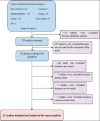Prevalence of Oral Lichen Planus in Diabetes Mellitus: a Meta-Analysis Study
- PMID: 28077900
- PMCID: PMC5203753
- DOI: 10.5455/aim.2016.24.390-393
Prevalence of Oral Lichen Planus in Diabetes Mellitus: a Meta-Analysis Study
Abstract
Background: Oral lichen planus (OLP) is associated with various other systemic conditions such as hypertension, diabetes mellitus (DM). This study evaluated the prevalence of OLP in DM patients compared with non-diabetic control subjects in a meta-analysis study.
Methods: In this study from January 1973 to August 2016, we searched the studies in Web of Science, Medline/PubMed, Scopus, Science direct, SID (Scientific Information Database), Cochrane and Embase databases. Strategy search was the Medical Subject Heading (MeSH) term oral lichen planus or oral mucosa combined with diabetes in PubMed and this search in other databases. Heterogeneity between estimates was evaluated by the Q and I2 statistic. Also, publication bias was assessed through funnel plot analysis with the Kendall's and Egger's tests.
Results: From 831 studies were identified with different search strategies, 11 studies met the criteria to be included in meta-analysis (11 case-control studies). The overall prevalence of OLP in 11 studies with 4937 DM patients and 3698 control subjectswas 1.5% and 0.75%, respectively. In this meta-analysis, the OR in prevalence of OLP in DM patients compared with control subjects was 1.584 (95%CI1.013-2.477; P=0.044) with a low level of heterogeneity (I2 = 0%) that the result showed the prevalence of OLP in DM patients is significantly more than control subjects.
Conclusions: This meta-analysis study showed an association between OLP with DM, whereas this association was no significant in previous studies, it was probably because different selecting of age, sex, type of DM, medications and criteria. Totally, the meta-analysis showed the risk of OLP in DM was higher compared with control subjects.
Keywords: Diabetes mellitus; Meta-analysis study; Oral lichen planus.
Conflict of interest statement
• Conflict of interest: none declared
Figures



Similar articles
-
Serum level of Interleukin-8 in subjects with diabetes, diabetes plus oral lichen planus, and oral lichen planus: A biochemical study.Dent Res J (Isfahan). 2016 Sep;13(5):413-418. doi: 10.4103/1735-3327.192277. Dent Res J (Isfahan). 2016. PMID: 27857766 Free PMC article.
-
Global Prevalence and Incidence Estimates of Oral Lichen Planus: A Systematic Review and Meta-analysis.JAMA Dermatol. 2020 Feb 1;156(2):172-181. doi: 10.1001/jamadermatol.2019.3797. JAMA Dermatol. 2020. PMID: 31895418 Free PMC article.
-
Prevalence of oral lichen planus in diabetes mellitus according to the type of diabetes.Oral Dis. 1998 Mar;4(1):37-40. doi: 10.1111/j.1601-0825.1998.tb00253.x. Oral Dis. 1998. PMID: 9655043
-
Depression, anxiety, and stress in oral lichen planus: a systematic review and meta-analysis.Clin Oral Investig. 2022 Feb;26(2):1391-1408. doi: 10.1007/s00784-021-04114-0. Epub 2021 Aug 30. Clin Oral Investig. 2022. PMID: 34460001 Free PMC article.
-
Evaluation of Potential Risk Factors that contribute to Malignant Transformation of Oral Lichen Planus: A Literature Review.J Contemp Dent Pract. 2016 Aug 1;17(8):692-701. doi: 10.5005/jp-journals-10024-1914. J Contemp Dent Pract. 2016. PMID: 27659090 Review.
Cited by
-
Serum and Salivary IgA, IgG, and IgM Levels in Oral Lichen Planus: A Systematic Review and Meta-Analysis of Case-Control Studies.Medicina (Kaunas). 2018 Dec 3;54(6):99. doi: 10.3390/medicina54060099. Medicina (Kaunas). 2018. PMID: 30513983 Free PMC article.
-
A systematic review and meta-analysis study of salivary and serum interleukin-8 levels in oral lichen planus.Postepy Dermatol Alergol. 2018 Dec;35(6):599-604. doi: 10.5114/ada.2018.77611. Epub 2018 Nov 13. Postepy Dermatol Alergol. 2018. PMID: 30618528 Free PMC article.
-
Evaluation of the Salivary Level of Cortisol in Patients with Oral Lichen Planus: A Meta-Analysis.Medicina (Kaunas). 2019 May 27;55(5):213. doi: 10.3390/medicina55050213. Medicina (Kaunas). 2019. PMID: 31137861 Free PMC article.
-
Oral Health Messiers: Diabetes Mellitus Relevance.Diabetes Metab Syndr Obes. 2021 Jul 1;14:3001-3015. doi: 10.2147/DMSO.S318972. eCollection 2021. Diabetes Metab Syndr Obes. 2021. PMID: 34234496 Free PMC article. Review.
-
Effect of diabetes mellitus type 2 on salivary glucose, immunoglobulin A, total protein, and amylase levels in adults: A systematic review and meta-analysis of case-control studies.J Res Med Sci. 2018 Oct 26;23:89. doi: 10.4103/jrms.JRMS_135_18. eCollection 2018. J Res Med Sci. 2018. PMID: 30505327 Free PMC article. Review.
References
-
- Mozaffari HR, Rahmani M, Rezaei F, Sadeghi M, Sharifi R, Ejtehadi A. Evaluation of oral lichen planus frequency in patients referred to pathology centers of Kermanshah city, during 2008 to 2011. Sch J App Med Sci. 2016;4(6E):2200–2.
-
- Carazzo M, Thorpe R. Oral lichen planus: a review. Minerva Stomatol. 2009;58(10):519–37. - PubMed
-
- Torrente-Castells E, Figueiredo R, Berini-Aytés L, Gay-Escoda C. Clinical features of oral lichen planus. A retrospective study of 65 cases. Med Oral Patol Oral Cir Bucal. 2010;15(5):e685–90. - PubMed
-
- Canter PH, Wider B, Ernst E. The antioxidant Vitamins A, C, E and selenium in the treatment of arthritis: A systematic review of randomized clinical trials. Rheumatology (Oxford) 2007;46(8):1223–33. - PubMed
LinkOut - more resources
Full Text Sources
Other Literature Sources
Medical
Miscellaneous
